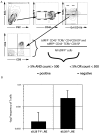Temporal specification of blood progenitors from mouse embryonic stem cells and induced pluripotent stem cells
- PMID: 20659975
- PMCID: PMC2938916
- DOI: 10.1242/dev.042119
Temporal specification of blood progenitors from mouse embryonic stem cells and induced pluripotent stem cells
Abstract
The efficient and reproducible generation of differentiated progenitors from pluripotent stem cells requires the recapitulation of appropriate developmental stages and pathways. Here, we have used the combination of activin A, BMP4 and VEGF under serum-free conditions to induce hematopoietic differentiation from both embryonic and induced pluripotent stem cells, with the aim of modeling the primary sites of embryonic hematopoiesis. We identified two distinct Flk1-positive hematopoietic populations that can be isolated based on temporal patterns of emergence. The earliest arising population displays characteristics of yolk sac hematopoiesis, whereas a late developing Flk1-positive population appears to reflect the para-aortic splanchnopleura hematopoietic program, as it has reduced primitive erythroid capacity and substantially enhanced myeloid and lymphoid potential compared with the earlier wave. These differences between the two populations are accompanied by differences in the expression of Sox17 and Hoxb4, as well as in the cell surface markers AA4.1 and CD41. Together, these findings support the interpretation that the two populations are representative of the early sites of mammalian hematopoiesis.
Figures







Similar articles
-
The stepwise specification of embryonic stem cells to hematopoietic fate is driven by sequential exposure to Bmp4, activin A, bFGF and VEGF.Development. 2008 Apr;135(8):1525-35. doi: 10.1242/dev.011767. Epub 2008 Mar 13. Development. 2008. PMID: 18339678
-
A Quantitative Proteomic Analysis of Hemogenic Endothelium Reveals Differential Regulation of Hematopoiesis by SOX17.Stem Cell Reports. 2015 Aug 11;5(2):291-304. doi: 10.1016/j.stemcr.2015.07.008. Stem Cell Reports. 2015. PMID: 26267830 Free PMC article.
-
Conversion from mouse embryonic to extra-embryonic endoderm stem cells reveals distinct differentiation capacities of pluripotent stem cell states.Development. 2012 Aug;139(16):2866-77. doi: 10.1242/dev.078519. Epub 2012 Jul 12. Development. 2012. PMID: 22791892 Free PMC article.
-
Sox17 and Other SoxF-Family Proteins Play Key Roles in the Hematopoiesis of Mouse Embryos.Cells. 2024 Nov 7;13(22):1840. doi: 10.3390/cells13221840. Cells. 2024. PMID: 39594589 Free PMC article. Review.
-
Erythro-myeloid progenitors: "definitive" hematopoiesis in the conceptus prior to the emergence of hematopoietic stem cells.Blood Cells Mol Dis. 2013 Dec;51(4):220-5. doi: 10.1016/j.bcmd.2013.09.006. Epub 2013 Oct 2. Blood Cells Mol Dis. 2013. PMID: 24095199 Free PMC article. Review.
Cited by
-
An interplay between extracellular signalling and the dynamics of the exit from pluripotency drives cell fate decisions in mouse ES cells.Biol Open. 2014 Jun 20;3(7):614-26. doi: 10.1242/bio.20148409. Biol Open. 2014. PMID: 24950969 Free PMC article.
-
Advances in understanding and treating dystrophic epidermolysis bullosa.F1000Prime Rep. 2014 May 6;6:35. doi: 10.12703/P6-35. eCollection 2014. F1000Prime Rep. 2014. PMID: 24860657 Free PMC article. Review.
-
BMP signaling balances murine myeloid potential through SMAD-independent p38MAPK and NOTCH pathways.Blood. 2014 Jul 17;124(3):393-402. doi: 10.1182/blood-2014-02-556993. Epub 2014 Jun 3. Blood. 2014. PMID: 24894772 Free PMC article.
-
In Vitro Differentiation of Gata2 and Ly6a Reporter Embryonic Stem Cells Corresponds to In Vivo Waves of Hematopoietic Cell Generation.Stem Cell Reports. 2018 Jan 9;10(1):151-165. doi: 10.1016/j.stemcr.2017.11.018. Epub 2017 Dec 21. Stem Cell Reports. 2018. PMID: 29276152 Free PMC article.
-
B-1 B cell development in the fetus and adult.Immunity. 2012 Jan 27;36(1):13-21. doi: 10.1016/j.immuni.2011.11.017. Immunity. 2012. PMID: 22284417 Free PMC article. Review.
References
-
- Boisset J. C., van Cappellen W., Andrieu-Soler C., Galjart N., Dzierzak E., Robin C. (2010). In vivo imaging of haematopoietic cells emerging from the mouse aortic endothelium. Nature 464, 116-120 - PubMed
-
- Cho S. K., Bourdeau A., Letarte M., Zuniga-Pflucker J. C. (2001). Expression and function of CD105 during the onset of hematopoiesis from Flk1(+) precursors. Blood 98, 3635-3642 - PubMed
Publication types
MeSH terms
Substances
Grants and funding
LinkOut - more resources
Full Text Sources
Other Literature Sources
Medical
Miscellaneous

